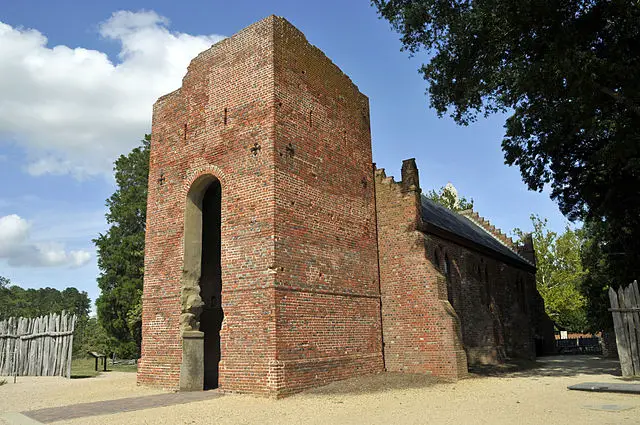Jamestown
Jamestown, Virginia, became the first permanent and successful settlement by the British in the New World. The colonists that arrived were looking to expand the land that was under British rule and also looked for any gold, silver, or minerals that they could send back to England. Jamestown was officially founded in 1607, and for over 80 years, it remained the capital of the colony of Virginia.

- King James I of England was eager to compete with other European countries as they all explored to look for new trade routes, land, and profit. He gave the Virginia Company of London the charter to create a new colony in the New World in 1606. This charter included financing the exploration expedition of three ships, 105 settlers, and 39 crewmen. In 1606 the three ships set sail for what is now called North America.
- To replenish food and water, the ships landed on the Canary Islands, the Caribbean Islands, and Puerto Rico. By 1607 the three ships landed at what is now called Cape Henry, Virginia. It took the ships four months from leaving England, their stops, and then their arrival.
- To survive, the settlers had to choose a location to build a fort. As they went up and down the coast, they finally picked a spot that could be defended against the Native Indian attacks. They constructed a fort that was in the shape of a triangle and named their new settlement Jamestown after King James I.
- The settlers arrived to a portion of land that wasn’t the best choice. The winters were harshly cold, and the summers were filled with mosquitoes, poison water, and swamps.
- The first group of Jamestown settlers was all men, and a majority had no idea how to farm, hunt, fish, or survive. These were mostly British gentlemen that were on the hunt for gold, silver, and minerals to take back to England. These men were also not used to any form of a hard life, and many didn’t survive the first years at Jamestown.
- In the first year of the settlement, over half of those that had arrived had already died of starvation, diseases, and water-borne germs. Some were killed in battles with the Powhatan Native Indian tribe. However, it was thanks to the Powhatan’s that some survived. The Native Indians helped the settlers by supplying food and items of survival as well as showing them how to hunt, fish, and farm. Some settlers caused the problem with the Powhatan tribe, and the Indians took revenge by kidnaping anyone that left the settlement.
- Things were looking grim for the settlement until Captain John Smith decided to take command and tried to get a better relationship with the Powhatans. He was kidnapped when he tried to visit the chief, and it was then that the chief’s daughter, Pocahontas, stepped in and saved his life. From that time on, there were better relationships between the settlers and the Indians, including trade.
- Smith was very experienced as a soldier and at sea. By being the leader, John Smith taught the settlers what they needed to survive and set up new laws that required that everyone worked if they wanted to eat. He sent word back to the Virginia Company to stop sending people that weren’t qualified and instead send laborers skilled in such areas as blacksmiths, farming, and carpentry.
- In 1609 John Smith had to return to England due to an injury, and when he left, it became the worst year for the settlement. It was known as the “starving time” because the harsh winter killed off 440 of the 500 settlers that were living there.
- When England sent fresh supplies and new colonists in the spring, everyone decided to try to remain and make the colony a success.
Q&A:
What year was Jamestown officially founded?
1607
Who was Jamestown named for?
King James I
What Native Indian tribe did the Jamestown settlers have to deal with?
Powhatan
Who took over as leader of Jamestown that ultimately allowed it to survive?
John Smith
Why was the area chosen for Jamestown a bad choice?
Harsh winters, summers with swamps, poison water, and mosquitoes
How many years was Jamestown the capital of Virginia?
80



